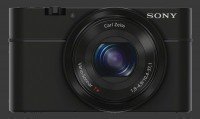Panasonic Lumix DMC-LX7 Review
Panasonic Lumix DMC-LX7 Performance - How well does it take pictures?
Choosing a digital camera is all about results: Getting the image quality you need and photographs the way you like them. Compact digital cameras generally have it tough because they suffer from small sensors and limited controls. The Panasonic Lumix DMC-LX7 is made to address these two concerns while maintaining the size of a compact camera.
The LX7 uses a larger-than-usual 1/1.7" CMOS sensor, similar to those used by Canon and Nikon in their small premium compacts, which is a little smaller then those used by Fuji but significantly smaller than the sensor in the Sony Cybershot DSC-RX100
Sony Cybershot DSC-RX100. The key to competing with larger sensor cameras is to use a bright lens which is exactly what Panasonic did for this digital camera. With its maximum aperture of F/1.4 at wide-angle, the LX7 can shoot at an ISO which is one or two stops lower than larger competitors. Crucially, the lens only stops down to F/2.3 at the long end, maintaining its lead throughout the zoom range.

Image noise is absent from images at the base sensitivity of ISO 80 and stays unintrusive until ISO 200, making 12" x 9" prints clean and crisp. ISO 400 shows some visible noise and a little more at ISO 800. Still, both these sensitivities have usable for mid-sized prints. In good light, ISO 1600 will too. By ISO 3200, noise destroys fine details and the smallest prints are possible. ISO 12800 is best avoided. Compared to its competitors, this is in-fact a very good performance, falling behind only the Sony RX100.
Colors of the Panasonic LX7 are problematic for those shooting JPEG images. Despite numerous Photo Styles and parameters, colors never get entirely real. Best results are obtained using Standard style with Saturation at -1. The default contrast is somewhat dull but increasing it causes premature clipping. Sharpness is good at the default setting. Above that it shows some moderate over-sharpening artifacts which are only noticeable in large prints.
Noise-reduction settings offer a compromise between noise and details. Levels -2 and -1 offer moderate noise-reduction with little effect on fine-details. Levels 1 and 2 make things look plastically and wipe-out fine-details. The default balances a little noise-reduction with a mild effect on image details. Those shooting mostly low-ISO images would prefer turning noise-reduction down while it is not entirely unreasonable to leave NR to its default for high-ISO images.
The other part of color rendition is white-balance. The Automatic White-Balance system on the LX7 constantly struggles, leaving a strong color cast in the presence artificial lighting. Custom WB works very well though, so the AWB issue is avoidable with time and discipline.
The Multi-Segment metering of this digital camera is average. It tends to clip highlights by 1/3 EV at night but sometimes under-exposes too. Overall, it does a reasonable job and rarely misses by more than one stop. At least, a preview is shown when the shutter-release is pressed half-way. Dynamic-range is much improved for a compact camera but not class-leading. As usual, it dynamic-range diminishes quickly as ISO increases, so for night photography, it is preferable to use long shutter-speeds and low ISO sensitivities. This is where the built-in HDR really shines, check out the difference:
Optically, the 24-90mm F/1.4-2.3 lens of the LX7 is very good. There is visible barrel distortion at the wide-angle end which quickly disappears after zooming in a little. Vignetting and chromatic aberrations are nowhere to be found. Corner softness is noticeable at large apertures. By F/2.8 at the wide-end or F/4 at the long end, corners become quite sharp. Our review unit showed some decentering with more pronounced softness on the lower-left corner. Otherwise, the lens is sufficiently sharp for its sensor.
The sensor in this Panasonic is a new 10 megapixels high-speed sensor which processes much faster than its predecessor. This lets the LX7 reach continuous shooting speeds of up to 11 FPS at full-resolution and also makes it possible to record 1080p HD video at a progressive 60 FPS. It actually has a mechanical shutter which can operate at 11 FPS.
Once on, the Lumix LX7 is generally quite responsive. The camera starts reacting immediately to most button presses and continues to do so what it is writing to the memory card. For long exposures, the camera employs dark-frame substraction which locks it up for a duration equal to the exposure time. A nice touch is that the LX7 counts down the exposure time and the dark-frame substraction time, so the photographer knows how much patience is needed.
The performance of this compact digital camera is characterized by the following measurements:
- Power On: 2s. Average for an extending lens camera. Longer if the Lens Resume option is selected.
- Autofocus: ¼s in moderate to good light. Down to ½s in low-light. A little longer in very low-light but rarely more than ¾s. A class-leading performance.
- Zoom: About 3s from widest to longest. Glacially slow, particularly considering the short 4X optical zoom range.
- Image Shutter-Lag: Instant. Excellent.
- Video Shutter-Lag: 1s. Below average.
- Black Out: ½s. Good for a fixed-lens camera.
- Shot-to-Shot speed: Just under 1½s with AF, just above 1s in MF mode. Very good. Add another ¾s for ISO 3200 and above.
- Time-to-first shot: 2½s. Good considering most of that time is spend powering on. Longer if the Lens Resume option is selected.
- Playback: About ¼s to enter or exit, assuming the lens is still extended. Very good.
- Power Off: 3s. Slow. This is from wide-angle. It takes longer with the lens zoomed in.
The Panasonic LX7 is really fast where it counts the most: shutter-lag, autofocus and shot-to-shot speeds. The zoom speed which could really stand to be improved. Other below average aspects are of minor importance to photographers.

Battery-life of the LX7 is short at 330 shots-per-charge, according to the CIPA measurement standard. This is even more true if shooting in low-light where exposure-times are long and the LX7 slows down to apply noise-reduction. Avoiding the built-in flash extends this a bit but a second battery is highly recommended to make it through long days of shooting.
Panasonic Lumix DMC-LX7 Performance - How well does it shoot video?
The Panasonic Lumix DMC-LX7 is one of the smallest digital cameras to record full 1080p HD video at 60 FPS with stereo sound. It saves such videos using the efficient AVCHD codec which also supports 1080p @ 30 FPS and 720p @ 60 FPS. Additionally, it can use the standard and easier to manage MPEG-4 codec for 1080p, 720p and VGA video but only at 30 FPS. A High-Speed Video mode captures 720p video at 120 FPS using the MPEG-4 as well.

Automatic video can be recorded in any mode by pressing the dedicated Video-Record button. Recording starts after an annoying 1s lag. The same button also stops video recording and unfortunately cuts off the last second from the video, so remember to wait after the action finishes to press the button.
Manual exposure is possible in Video mode. All PASM modes are available with the ISO range limited to 6400 and shutter-speed to 1/8s which is oddly slower than the frame-rate. The LX7 goes one step further by allowing exposure parameters to be changed during filming. One must be careful though since it is easy to jerk the camera while going so. Aperture ring clicks get recorded by the built-in microphone, so it is best to do this with an external one.
It is possible to zoom and focus while recording video. The zoom moves extremely slowly to avoid adding noise to the sound track. In AF-S mode, focus is locked before recording starts by pressing the shutter halfway. In AF-C mode, focus is continuously adjusted. Either normal or Face-Detect autofocus is available in AF-C mode.
The Panasonic Lumix DMC-LX7 produces videos of excellent quality and its 60 FPS frame-rate renders motion smoother than any other compact digital camera to date. Details are rendered sharply without easily noticeable artifacts. Panning with the LX7 is simply impressive. Color and white-balance behave exactly as in image mode, being good but not perfect, particularly under artificial light. All metering modes are available for videos and the camera adjusts very smoothly when brightness changes.
Video performance of the LX7 is really great except for the 1s delay and 1s cut-off at beginning and end of video, respectively. With some anticipation and practice, these issues can be overcome. Once past these, it is easy to appreciate the quality of videos produced by this digital camera.
Panasonic Lumix DMC-LX7 Conclusion

The Panasonic Lumix DMC-LX7 is one of the few cameras aimed at the middle ground between P&S models and DSLR cameras. Its body and fixed lens makes it closer to compacts yet it manages to surpass them by combining a larger sensor and extremely bright lens. Image quality overall is very good, particularly if shooting RAW. In terms of speed, it delivers an excellent performance where it counts the most with zoom being the only overly slow aspect.
The LX7 offers a rich feature-set, including optional EVF and Hot-Shoe. Its lens has versatile ultra-wide to short telephoto reach with excellent optical quality. Most importantly, this digital camera offers plenty external controls to make operating it more efficient, something which is highly important for advanced users. It's class-leading video performance also deserves a special mention.
The sum of all this is a well-built compact camera with advanced features that fills its promise well and can be easily recommended as an excellent digital camera for creative photography. Its ergonomics handle quite well with only the modal EC interface slowing things down.
 |
Please Support Neocamera
All information on Neocamera is provided free of charge yet running this website is a huge endeavor. Purchases made via affiliate links found throughout the site help keep it running and up-to-date. There is no additional cost to you, so please consider buying via these links to our affilates:
Thank you for your support!
Panasonic DMC-LX7 Highlights

Sensor-Size: 8 x 6mm

Actual size when viewed at 100 DPI
| 10 Megapixels Fixed Lens | ISO 80-6400 |
| 3.8X Ultra-Wide Optical Zoom | Shutter 1/4000-250s |
| Built-in Stabilization | Full manual controls, including Manual Focus |
| 0.44" Optional EVF 1.4 Megapixels | Custom white-balance with 2 axis fine-tuning |
| 2 Axis Digital Level | Spot-Metering |
| 11 FPS Drive, 12 Images | Hot-Shoe |
| 1920x1080 @ 60 FPS Video Recording | Lithium-Ion Battery |
| 3" LCD 920K Pixels | Secure Digital Extended Capacity, Internal Memory |
Updates
2025.11.13

Best Gifts for Photographers in 2025 by Budget
The annual Neocamera Photography Gift Guide updated to 2025. Find great gifts for photographers with any price budget.
2025.07.07

Stellar Photo Recovery Review
Review of Stellar Photo Recovery V12. This Windows and MacOS software can recover photos and videos in a huge number of formats from memory cards, USB drives, SSDs and HHDs.
2025.05.14

Huion Kamvas 13 Gen 3 Review
In-Depth review of the Huion Kamvas 13 Gen 3 Pen Display Tablet for photographers and graphic artists.
2025.01.18

Fujifilm GFX 2025 Lens Roundup
Lens Review roundup of Fujifilm GFX Medium-Format lenses. Quality, performance and handling of the GF20-35mm F/4R WR, GF30mm F/3.5 Tilt-Shift and the GF55mm F/1.7.
2024.11.18

Best 2024 Photography Gifts for Every Budget
Great gifts for photographers and photo enthusiasts selected for every budget among the best products of 2024.
2024.08.07

Eye Protection Tips for Professional Photographers
The four main considerations for professional photographers regarding eyewear.
2024.07.14

Fujifilm X100VI Review
Flagship fixed-lens compact digital camera with a 40 MP sensor and Image-Stabilization, a first for the series. Retro design featuring dual control-dials, plus direct ISO, Shutter-Speed and EC dials. Its hybrid viewfinder can switch between EVF and OVF mode.
2024.05.09

Fujifilm GFX100 II Review
Flagship 102 Megapixels Medium-Format Mirrorless Digital Camera with 8-Stop 5-Axis IBIS, 8 FPS Drive, 8K Video and 400 MP Super-Resolution capture in a weatherproof and freezeproof body with dual control-dials and dual memory-card slots.
2024.04.03

Fujifilm X-T5 Review
Newest Fujifilm flagship boasting a 40 MP APS-C sensor, 5-axis IBIS with 7-stop efficiency, 15 FPS continuous drive, 6.2K Video capture, dual control-dials and dual SDXC UHS-II slots in a sturdy weatherproof and freezeproof body.
2023.11.20

Best Digital Cameras of 2023
Find out which are the Best Digital Cameras of 2023. All the new Mirrorless Digital Cameras from entry-level to high-end professional.
2023.07.10

Fujifilm X-H2 Review
40 Megapixels APS-C Hybrid Mirrorless Digital Camera with 7-stop IBIS. Fastest shutter ever and 8K video capture. Large builtin EVF with 0.8X magnification and 5.8 MP, plus an Eye-Start Sensor. Packed with features and large number of controls in a weatherproof and freezeproof body.
2023.05.07

Sony FE 20-70mm F/4G Review
Review of the unique Sony FE 20-70mm F/4G lens. The optical zoom of this lens spans ultra-wide-angle and medium focal-length coverage, making it one of the most versatile Full-Frame lenses on the market.











